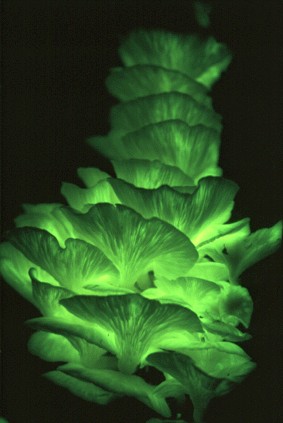
Classification
Domain: Eukarya
All organisms included in this domain possess eukaryotic cells.
A eukaryotic cell is a type of cell with a membrane-enclosed
nucleus and membrane-enclosed organelles. (Campbell and Reece
et. al 2009) Eukaryotic cells are the main differentiation
between domain Eukarya and domain Archae and Eubacteria.
Omphalotus nidiformis is classified into this domain
because it has a membrane-enclosed nucleus and membrane-enclosed
organelles. Examples of other organisms which are classified
into domain Eukarya include
Asimina triloba, Pawpaw Fruit and
Cryptotethya Crypta, Sea Sponges.
Kingdom: Fungi
Members of this kingdom are heterotrophs, decomposers, parasites, or
mutualists, which possess hyphae, are supported structurally by
chitinous cell walls, and have the ability to reproduce through
sexual and asexual life cycles. O. nidiformis is classified
into this kingdom because it is a heterotroph, meaning it feeds off
others in order to survive, possesses hyphae, which will be
discussed in greater detail in the
Reproduction page, is supported by chitinous cell walls, and
reproduces through a sexual life cycle. Other interesting fungi
include
Aspergillus fumigatus, A Human Pathogenic Fungus and
Saccharomyces cerevisiae, Baker's and Brewer's Yeast.
Phylum: Basidiomycota
Mushrooms, puffballs, and shelf fungi named basidiomycetes, belong
to this phylum due to their externally-borne spores on a club-shaped
structure called a basidium. Omphalotus nidiformis
belongs to this phylum because of its externally-borne spores and
basidium. Another example of an organism that belongs to this phylum
is
Cyathus striatus, Bird's Nest Fungi. Fifteen
basidiomycota mushroom species were assessed for hemagglutination
and lectin activity. (Rouf et. al 2011) Omphalotus nidiformis
was even an organism included in this study. Hemagglutination is the
clumping together of red blood cells and lectin are sugar-binding
proteins that are highly specific for their sugar moieties. What
defined an organism of being lectin active was determined by the
ability of differing mono- and oligosaccharides to be active. Of the
mushrooms tested, there was a total of seven which showed lectin
activity. Six (one being O. nidiformis) expressed lectin
activity in only one of the two total collections. The remaining two
lectin active organisms showed activity with the same sugar in both
collections. (Rouf et. al 2011)
Class: Agaricomycetes
This is characterized by the presence of a pileus that is distinctly
differentiated from the stipe with lamellae underneath the pileus.
The pileus is the fleshy cap of the mushroom which is easily
damaged. On mushrooms, the stipe represents the stalk-like or stem
supporting the pileus. The lamellae located under the pileus refers
to the gill which aids in spore dispersal and increases the surface
area to volume ratio of the fungus. (Springbrook Research Centre
2011) This organism is classified into this class because it
possesses a pileus, a stipe, and a lamellae. Two organisms I find
particularly interesting are
Auricularia auricula-judae, The Jelly Ear Mushroom and
Ganoderma lucidum, Reishi or Lingzhi Mushroom.
Order: Agaricales
The organisms that belong to this order are the fungi you typically
think of when someone mentions a mushroom that is found in a
terrestrial environment. Omphalotus nidiformis is included
in this order because before this mushroom reaches maturity it looks
like the typical white button mushroom found on the top of your
pizza. Mushrooms that fall under this classification include
Amanita muscaria, The Fly Agaric,
Calvatia gigantea,
Giant Puffball and
Lentinula edodes, Shiitake Mushroom.
Family: Marasmiaceae
Omphalotus nidiformis is included in this family because
each organism has white spores, a tough stem, and the capability to
shrivel up during a dry period and recover.
Genus: Omphalotus
All members of this genus have a traditional cap and stem form,
they're saprotrophic and grow in clusters around trees. The best
known organism belonging to this genus is
Omphalotus olearus, The Jack-O'-Lantern Mushroom.
Similar to O. nidiformis, this organism causes
gastrointestinal symptoms after ingesting such as severe cramps,
vomiting, and diarrhea. One study took place testing the O.
olearus and O. nidiformis with the help of alkylating agents. (Schobert
et. al 2011) These agents were first found accidently in compounds
used for poisonous gas. Illudens were tested to show toxicity for
leukemia and other carcinoma cells. O. olearus and O. nidiformis
were tested against cancer cells but deemed powerful, but too toxic
for chemotherapeutics. (Schobert et. al 2011)

Species: Omphalotus nidiformis
This organism is found in Southern Australia and is most famous
for its bioluminescent properties. Omphalotus nidiformis'
scientific name is derived from the Latin word nidus meaning 'nest'
and forma meaning 'shape' or 'form' hence 'nest shaped.'
If you would like to continue learning about Omphalotus nidiformis, please continue on to the Phylogenetic Tree page.